HSBC 2002 Annual Report Download - page 292
Download and view the complete annual report
Please find page 292 of the 2002 HSBC annual report below. You can navigate through the pages in the report by either clicking on the pages listed below, or by using the keyword search tool below to find specific information within the annual report.-
 1
1 -
 2
2 -
 3
3 -
 4
4 -
 5
5 -
 6
6 -
 7
7 -
 8
8 -
 9
9 -
 10
10 -
 11
11 -
 12
12 -
 13
13 -
 14
14 -
 15
15 -
 16
16 -
 17
17 -
 18
18 -
 19
19 -
 20
20 -
 21
21 -
 22
22 -
 23
23 -
 24
24 -
 25
25 -
 26
26 -
 27
27 -
 28
28 -
 29
29 -
 30
30 -
 31
31 -
 32
32 -
 33
33 -
 34
34 -
 35
35 -
 36
36 -
 37
37 -
 38
38 -
 39
39 -
 40
40 -
 41
41 -
 42
42 -
 43
43 -
 44
44 -
 45
45 -
 46
46 -
 47
47 -
 48
48 -
 49
49 -
 50
50 -
 51
51 -
 52
52 -
 53
53 -
 54
54 -
 55
55 -
 56
56 -
 57
57 -
 58
58 -
 59
59 -
 60
60 -
 61
61 -
 62
62 -
 63
63 -
 64
64 -
 65
65 -
 66
66 -
 67
67 -
 68
68 -
 69
69 -
 70
70 -
 71
71 -
 72
72 -
 73
73 -
 74
74 -
 75
75 -
 76
76 -
 77
77 -
 78
78 -
 79
79 -
 80
80 -
 81
81 -
 82
82 -
 83
83 -
 84
84 -
 85
85 -
 86
86 -
 87
87 -
 88
88 -
 89
89 -
 90
90 -
 91
91 -
 92
92 -
 93
93 -
 94
94 -
 95
95 -
 96
96 -
 97
97 -
 98
98 -
 99
99 -
 100
100 -
 101
101 -
 102
102 -
 103
103 -
 104
104 -
 105
105 -
 106
106 -
 107
107 -
 108
108 -
 109
109 -
 110
110 -
 111
111 -
 112
112 -
 113
113 -
 114
114 -
 115
115 -
 116
116 -
 117
117 -
 118
118 -
 119
119 -
 120
120 -
 121
121 -
 122
122 -
 123
123 -
 124
124 -
 125
125 -
 126
126 -
 127
127 -
 128
128 -
 129
129 -
 130
130 -
 131
131 -
 132
132 -
 133
133 -
 134
134 -
 135
135 -
 136
136 -
 137
137 -
 138
138 -
 139
139 -
 140
140 -
 141
141 -
 142
142 -
 143
143 -
 144
144 -
 145
145 -
 146
146 -
 147
147 -
 148
148 -
 149
149 -
 150
150 -
 151
151 -
 152
152 -
 153
153 -
 154
154 -
 155
155 -
 156
156 -
 157
157 -
 158
158 -
 159
159 -
 160
160 -
 161
161 -
 162
162 -
 163
163 -
 164
164 -
 165
165 -
 166
166 -
 167
167 -
 168
168 -
 169
169 -
 170
170 -
 171
171 -
 172
172 -
 173
173 -
 174
174 -
 175
175 -
 176
176 -
 177
177 -
 178
178 -
 179
179 -
 180
180 -
 181
181 -
 182
182 -
 183
183 -
 184
184 -
 185
185 -
 186
186 -
 187
187 -
 188
188 -
 189
189 -
 190
190 -
 191
191 -
 192
192 -
 193
193 -
 194
194 -
 195
195 -
 196
196 -
 197
197 -
 198
198 -
 199
199 -
 200
200 -
 201
201 -
 202
202 -
 203
203 -
 204
204 -
 205
205 -
 206
206 -
 207
207 -
 208
208 -
 209
209 -
 210
210 -
 211
211 -
 212
212 -
 213
213 -
 214
214 -
 215
215 -
 216
216 -
 217
217 -
 218
218 -
 219
219 -
 220
220 -
 221
221 -
 222
222 -
 223
223 -
 224
224 -
 225
225 -
 226
226 -
 227
227 -
 228
228 -
 229
229 -
 230
230 -
 231
231 -
 232
232 -
 233
233 -
 234
234 -
 235
235 -
 236
236 -
 237
237 -
 238
238 -
 239
239 -
 240
240 -
 241
241 -
 242
242 -
 243
243 -
 244
244 -
 245
245 -
 246
246 -
 247
247 -
 248
248 -
 249
249 -
 250
250 -
 251
251 -
 252
252 -
 253
253 -
 254
254 -
 255
255 -
 256
256 -
 257
257 -
 258
258 -
 259
259 -
 260
260 -
 261
261 -
 262
262 -
 263
263 -
 264
264 -
 265
265 -
 266
266 -
 267
267 -
 268
268 -
 269
269 -
 270
270 -
 271
271 -
 272
272 -
 273
273 -
 274
274 -
 275
275 -
 276
276 -
 277
277 -
 278
278 -
 279
279 -
 280
280 -
 281
281 -
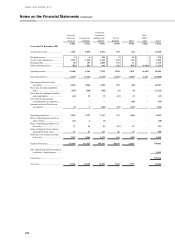 282
282 -
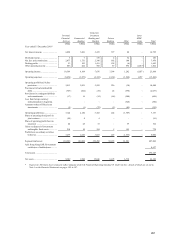 283
283 -
 284
284 -
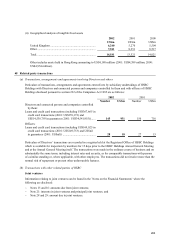 285
285 -
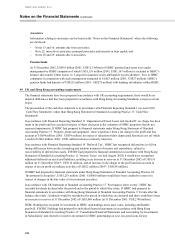 286
286 -
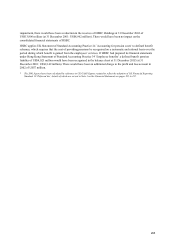 287
287 -
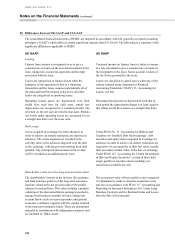 288
288 -
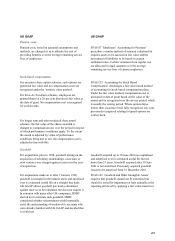 289
289 -
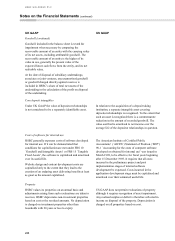 290
290 -
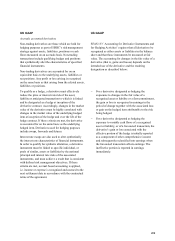 291
291 -
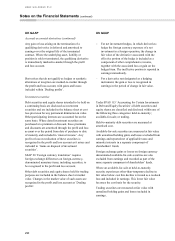 292
292 -
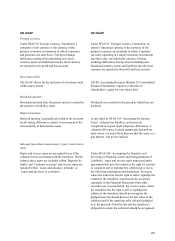 293
293 -
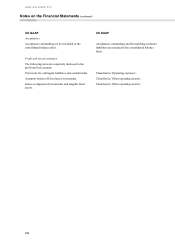 294
294 -
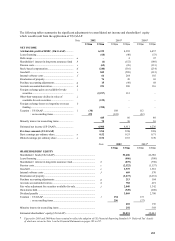 295
295 -
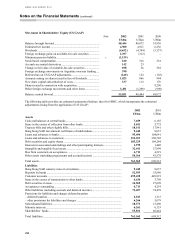 296
296 -
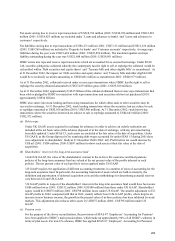 297
297 -
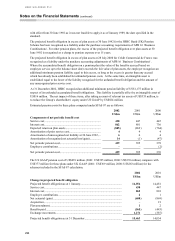 298
298 -
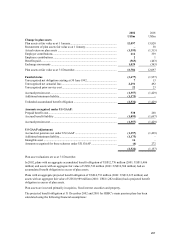 299
299 -
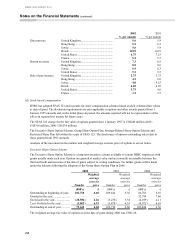 300
300 -
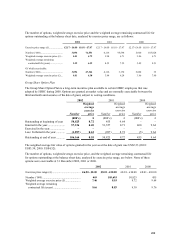 301
301 -
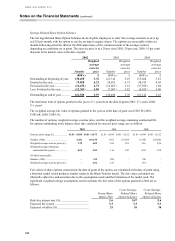 302
302 -
 303
303 -
 304
304 -
 305
305 -
 306
306 -
 307
307 -
 308
308 -
 309
309 -
 310
310 -
 311
311 -
 312
312 -
 313
313 -
 314
314 -
 315
315 -
 316
316 -
 317
317 -
 318
318 -
 319
319 -
 320
320 -
 321
321 -
 322
322 -
 323
323 -
 324
324 -
 325
325 -
 326
326 -
 327
327 -
 328
328 -
 329
329
 |
 |

HSBC HOLDINGS PLC
Notes on the Financial Statements (continued)
290
UK GAAP US GAAP
Accruals accounted derivatives (continued)
Any gain or loss arising on the termination of a
qualifying derivative is deferred and amortised to
earnings over the original life of the terminated
contract. Where the underlying asset, liability or
position is sold or terminated, the qualifying derivative
is immediately marked-to-market through the profit
and loss account.
− For net investment hedges, in which derivatives
hedge the foreign currency exposure of a net
investment in a foreign operation, the change in
fair value of the derivative associated with the
effective portion of the hedge is included as a
component of other comprehensive income,
together with the associated loss or gain on the
hedged item. The ineffective portion is reported in
earnings immediately.
Derivatives that do not qualify as hedges or synthetic
alterations at inception are marked-to-market through
the profit and loss account, with gains and losses
included within ‘Dealing profits’ .
– For a derivative not designated as a hedging
instrument, the gain or loss is recognised in
earnings in the period of change in fair value.
Investment securities
Debt securities and equity shares intended to be held on
a continuing basis are disclosed as investment
securities and are included in the balance sheet at cost
less provision for any permanent diminution in value.
Other participating interests are accounted for on the
same basis. Where dated investment securities are
purchased at a premium or discount, these premiums
and discounts are amortised through the profit and loss
account over the period from date of purchase to date
of maturity and included in ‘interest income’ . Any
profit or loss on realisation of these securities is
recognised in the profit and loss account as it arises and
included in ‘Gains on disposal of investment
securities’ .
SSAP 20 ‘Foreign currency translation’ requires
foreign exchange differences on foreign-currency-
denominated monetary items, including securities, to
be recognised in the profit and loss account.
Other debt securities and equity shares held for trading
purposes are included in the balance sheet at market
value. Changes in the market value of such assets are
recognised in the profit and loss account as ‘Dealing
profits’ .
Under SFAS 115 ‘Accounting for Certain Investments
in Debt and Equity Securities’ all debt securities and
equity shares are classified and disclosed within one of
the following three categories: held-to-maturity;
available-for-sale; or trading.
Held-to-maturity debt securities are measured at
amortised cost.
Available-for-sale securities are measured at fair value
with unrealised holding gains and losses excluded from
earnings and reported net of applicable taxes and
minority interests in a separate component of
shareholders’ funds.
Foreign exchange gains or losses on foreign currency
denominated available-for-sale securities are also
excluded from earnings and recorded as part of the
same separate component of shareholders’ funds.
Where an available-for-sale or held-to-maturity
security experiences other-than-temporary decline in
fair value below cost this decline is treated as a realised
loss and included in earnings. This lower fair value
becomes the cost basis for the security.
Trading securities are measured at fair value with
unrealised holding gains and losses included in
earnings.
